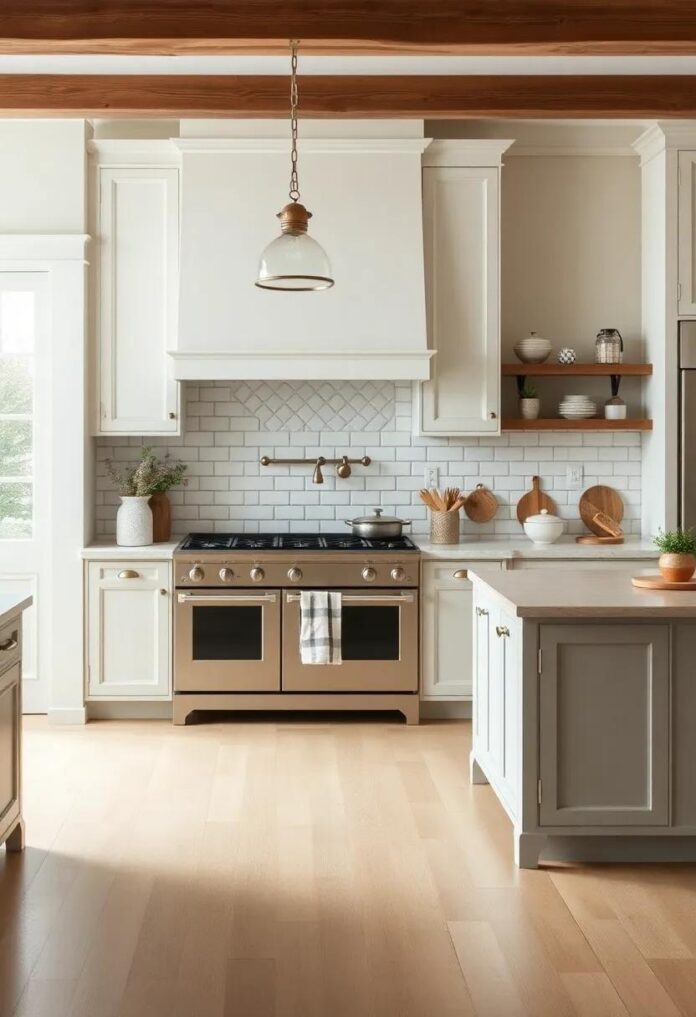In a world constantly captivated by fleeting trends and modern minimalism,the timeless allure of French farmhouse kitchen design stands as a steadfast refuge of warmth and charm.This article invites you to step into a realm where rustic elegance meets functional beauty, crafting spaces that resonate with both artful simplicity and rich history. From weathered wooden beams to soft pastel palettes, each element of the French farmhouse kitchen embodies a story, inviting you to create an ambiance that feels both lived-in and inviting. Join us on a journey through the essential qualities of this enchanting style, as we explore the harmonious blend of practicality and picturesque aesthetics that make the French farmhouse kitchen a cherished centerpiece in homes around the world. Whether you’re embarking on a renovation or simply seeking inspiration,prepare to embrace the charm that transcends time and trends in this delightful exploration of design.
Embracing Rustic Color Palettes That capture the Essence of French Countryside
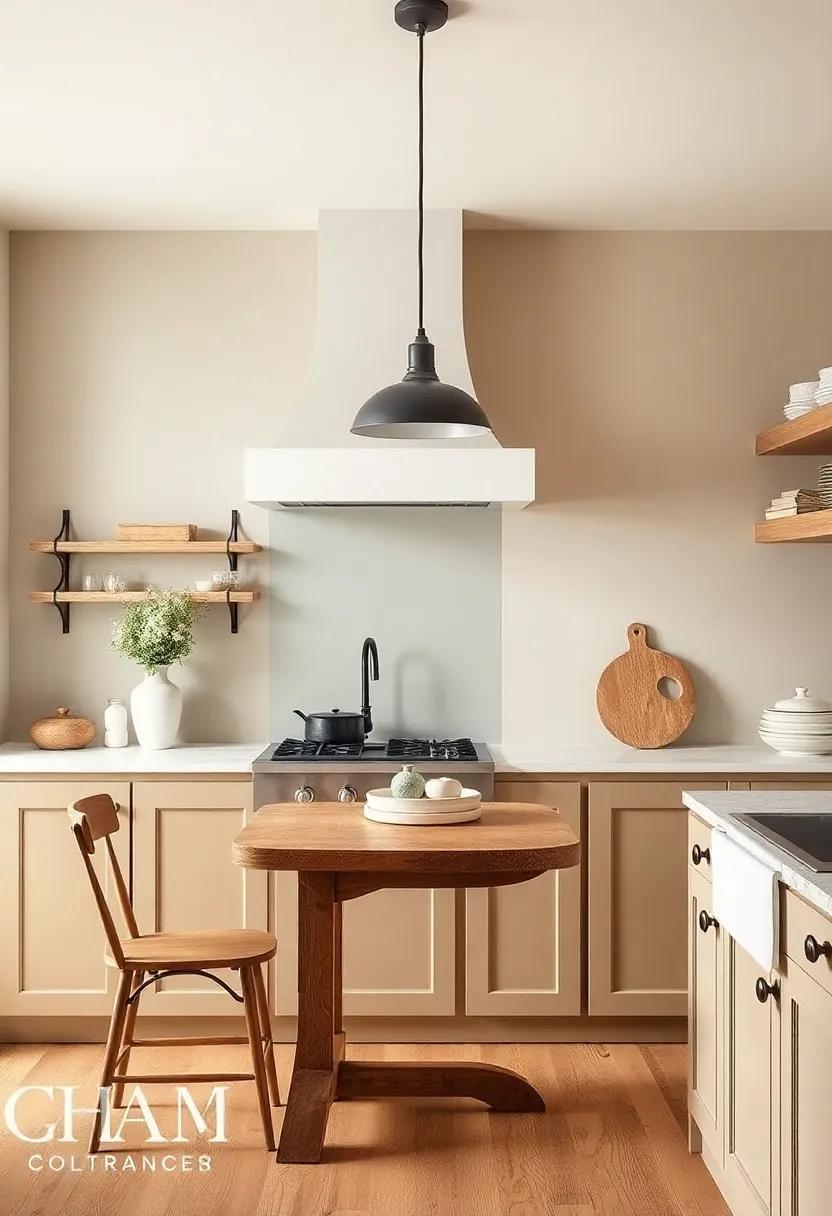
The allure of the French countryside lies in its rich and earthy color palettes that evoke a sense of serenity and nostalgia. When designing a farmhouse kitchen, consider incorporating warm, muted hues that capture the essence of natural elements.Soft ivory, weathered sage, and dusty lavender can serve as the perfect backdrop for rustic wooden cabinets and antique fixtures. Pair these tones with splashes of deep cobalt or faded terracotta for a lively contrast that mirrors the stunning landscapes of rural France.The key is to choose shades that harmonize well with each other, creating a soothing and inviting ambiance.
Textures play a crucial role in enhancing the rustic charm of your kitchen. Select materials that reflect age and authenticity, such as reclaimed wood, stone, and wrought iron. The combination of these elements, in synergy with your chosen color palette, will create a cohesive and timeless look. Consider these color pairings for your kitchen design:
| Primary Color | Accent Color | Suggested Material |
|---|---|---|
| Soft Ivory | Deep cobalt | wooden Beams |
| Weathered Sage | Rusty Burgundy | Stone Countertops |
| Dusty Lavender | Faded Terracotta | Wrought Iron Hooks |
Exploring Open Shelving as a Practical and Aesthetic Choice in Kitchen Design
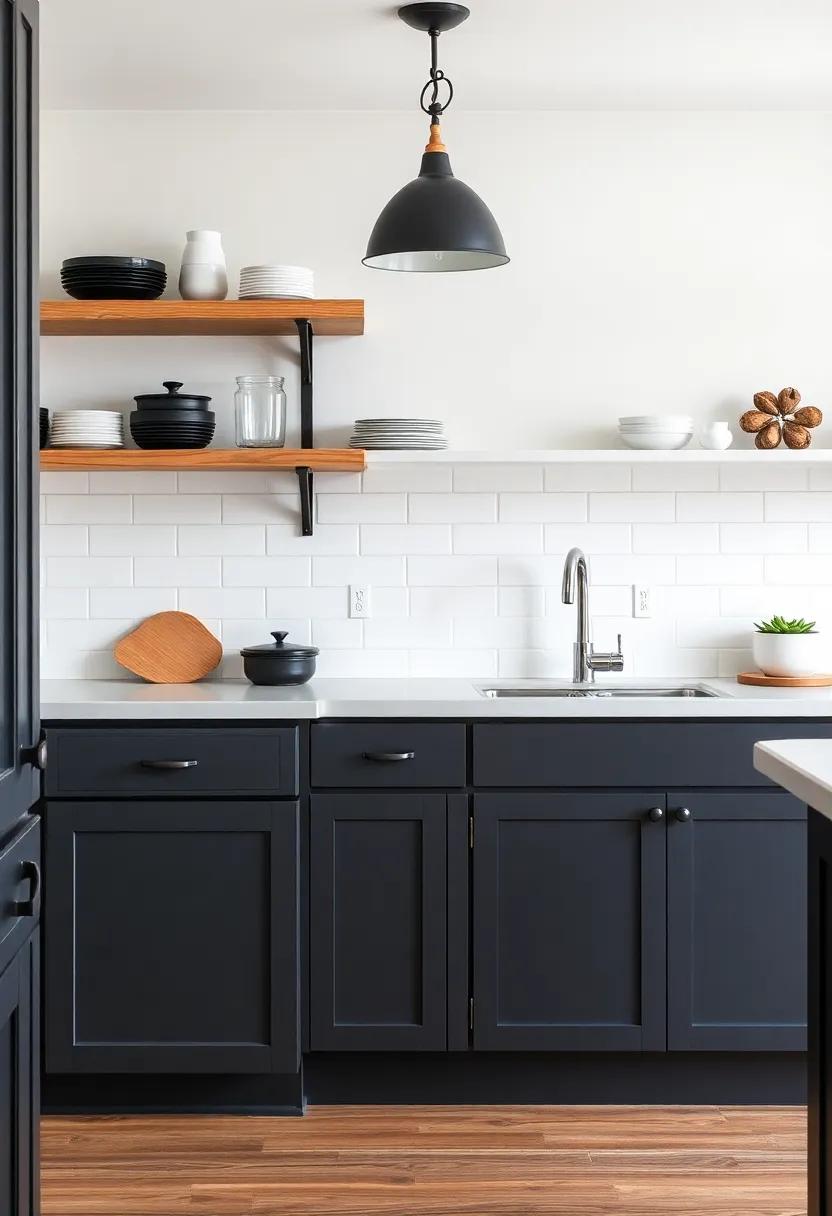
Open shelving has become a cherished feature in kitchen design, perfectly merging functionality with rustic charm, notably in a French farmhouse aesthetic. This design choice allows homeowners to showcase their beatiful dishware,artisanal kitchen tools,and vibrant cookbooks while keeping everyday essentials easily accessible. The appeal lies in its ability to create an airy atmosphere, making kitchens feel larger and inviting. When designed thoughtfully,open shelves can serve as a canvas for personal expression through curated collections and decorative items,enhancing the overall character of the space.
To create a visually appealing arrangement on open shelves, consider the following tips:
- Group like items: Cluster dishware or glassware by color or style for a cohesive look.
- Introduce texture: Mix materials, such as wooden boards, ceramic plates, and metal accents to add depth.
- incorporate greenery: Small potted herbs or decorative plants can enliven the space and connect to the farm-to-table ethos.
- Vary heights: Use stacks of books or risers to create diverse levels, allowing each piece to shine.
This thoughtful arrangement not only maximizes storage efficiency but also encourages a sense of creativity and warmth within the kitchen, drawing inspiration from the simple elegance of farmhouse style.
The Art of Combining Vintage Accessories with Modern Functionality in a french Kitchen
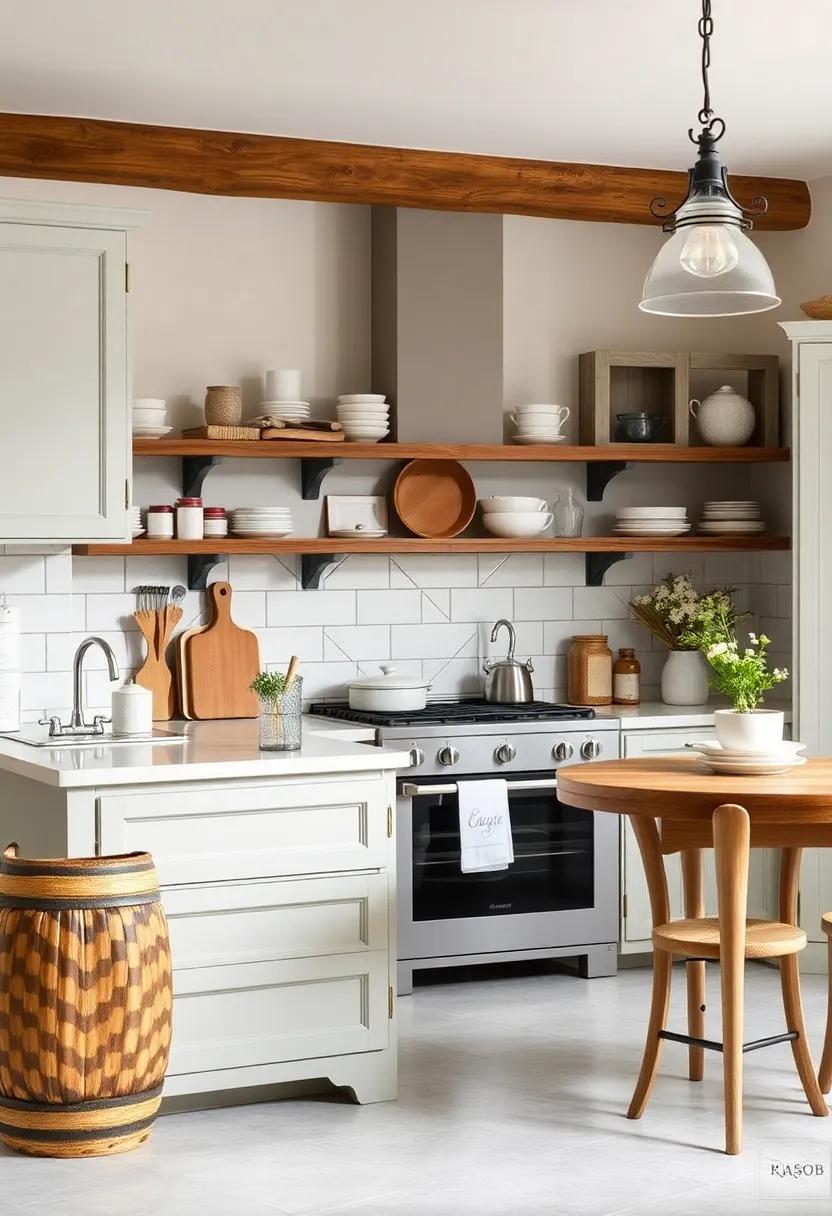
In the heart of a French kitchen, the beauty of vintage accessories is perfectly blended with modern functionality, creating a space that is both charming and practical. When choosing vintage pieces, consider items that tell a story or evoke nostalgia, such as antique utensil holders or vintage farmhouse tables. Incorporating these elements can be effortlessly accomplished by selecting accessories that complement the clean lines and contemporary finishes of your kitchen. A strategically placed enamelware pot or a set of aged wooden spoons can introduce warmth and personality, making the space feel inviting and lived-in.
To ensure that the vintage accessories serve a purpose beyond aesthetics,think about integrating them into the daily routine of your kitchen. Here are some practical ideas:
- Repurposed vintage jars: Use them for storage or as stylish containers for spices and herbs.
- Old wooden crates: Turn them into open shelving for displaying cookbooks and decorative items.
- Chalkboards: Utilize an old chalkboard for a modern twist on a menu or shopping list.
By mixing these timeless pieces with sleek, modern appliances and fixtures, you create a harmonious blend of old and new, ensuring that functionality is never sacrificed for style.
Inviting Natural Light to Enhance the Warmth and Charm of Your Cooking Space
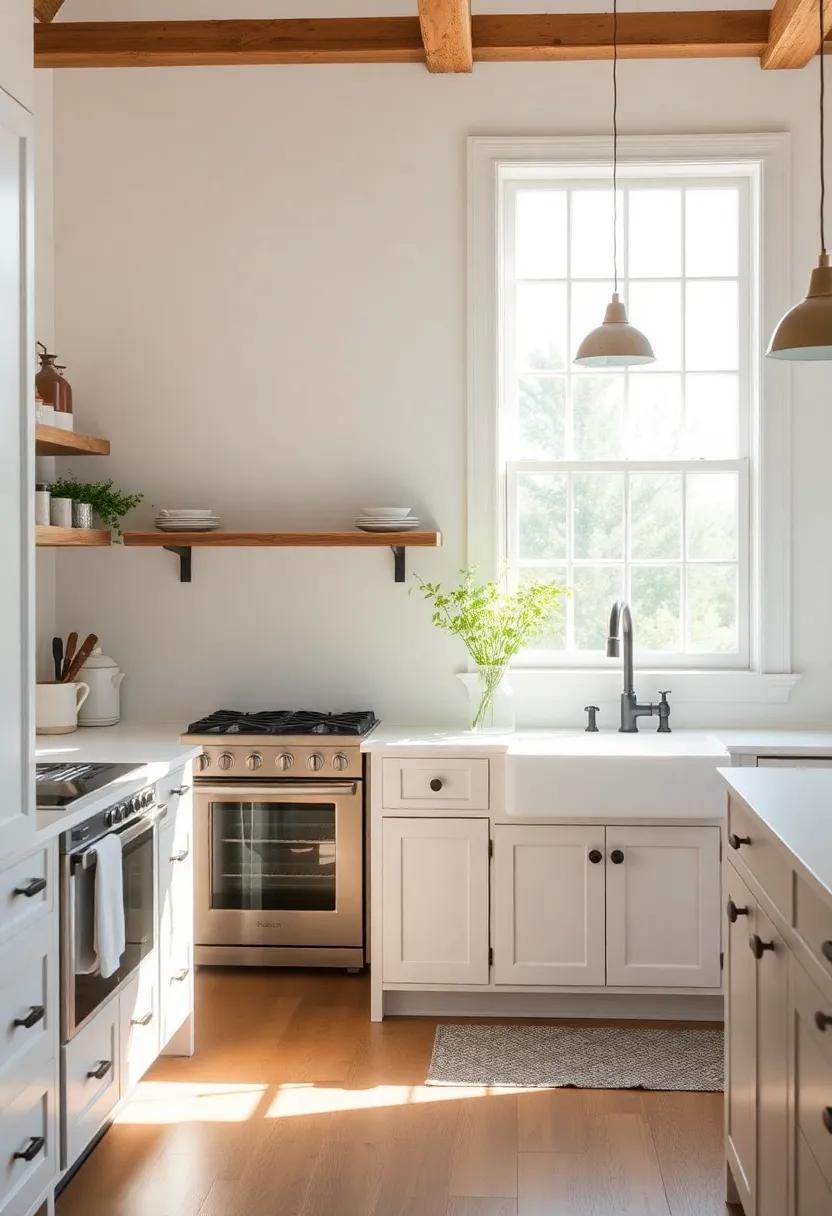
In a French farmhouse kitchen, the dance of natural light plays a crucial role in creating an inviting atmosphere. Large, well-placed windows allow sunlight to pour in, casting a warm glow over rustic wood cabinetry and artisanal ceramic tiles. To maximize this affect, consider incorporating features such as:
- Transom windows above doors for additional light.
- Skylights to bring daylit radiance into the heart of the kitchen.
- Light curtains that softly diffuse sunlight while maintaining privacy.
Incorporating light colors into cabinetry and decor can further reflect this natural brightness, enhancing the cozy charm of the space. Choosing a palette of whites and soft pastels not only amplifies the sense of openness but also harmonizes beautifully with natural wood tones and textured surfaces. The result is a kitchen where warmth and light converge, making it a space both functional and delightfully inviting. Consider utilizing a table for a fast visual representation of light-enhancing materials:
| Material | Light Impact |
|---|---|
| Glass | High clarity, excellent for direct light. |
| Light-colored Wood | Reflects natural light, creating a spacious feel. |
| Pastel Paints | softens brightness, enhances warmth. |
crafting a Cozy Ambiance through Thoughtful Textural layering in Kitchen Decor
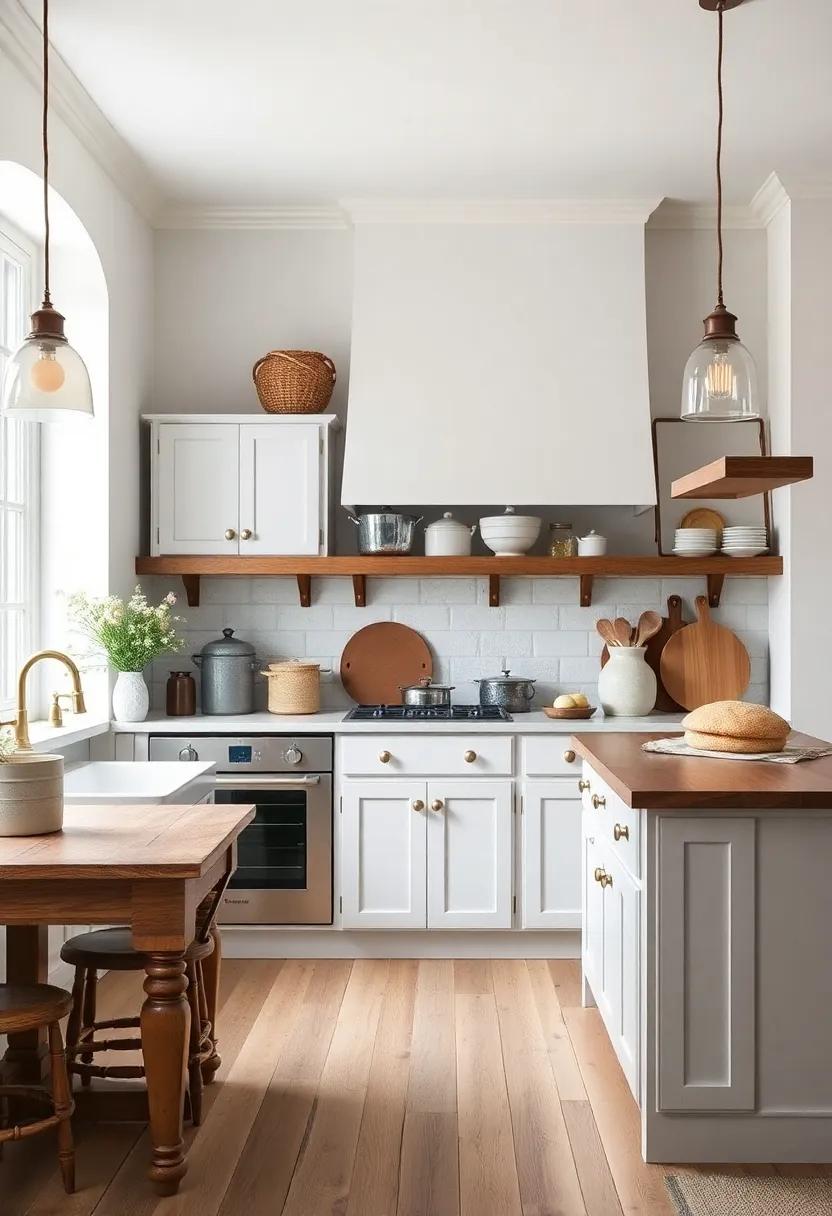
BEST-SELLING PRODUCTS IN THIS CATEGORY
- NKBA (National Kitchen and Bath Association) (Author)
Transform your kitchen into a warm haven by carefully layering textures that evoke the inviting charm of a French farmhouse. natural materials play a pivotal role in crafting this atmosphere, so consider incorporating elements such as:
- Wood: Reclaimed barnwood for open shelves or exposed beams.
- Stone: Rustic granite countertops or a limestone backsplash.
- Textiles: Soft linen curtains and plush cotton dish towels.
To enhance the visual dynamics,mix and match these materials with finishes that radiate warmth.Opt for handcrafted ceramics and vintage finds that carry stories of yesteryear.Think about using woven baskets for storage, which introduce a tactile element and a touch of nature. Additionally, a well-placed table with a distressed finish can serve as a striking centerpiece, further enhancing the layered textural experience. Pay attention to details—opting for matte over glossy finishes can deepen the rustic appeal, making your kitchen a captivating blend of elegance and comfort.
The Timeless Appeal of Dining Tables: Centerpieces of Family Gatherings
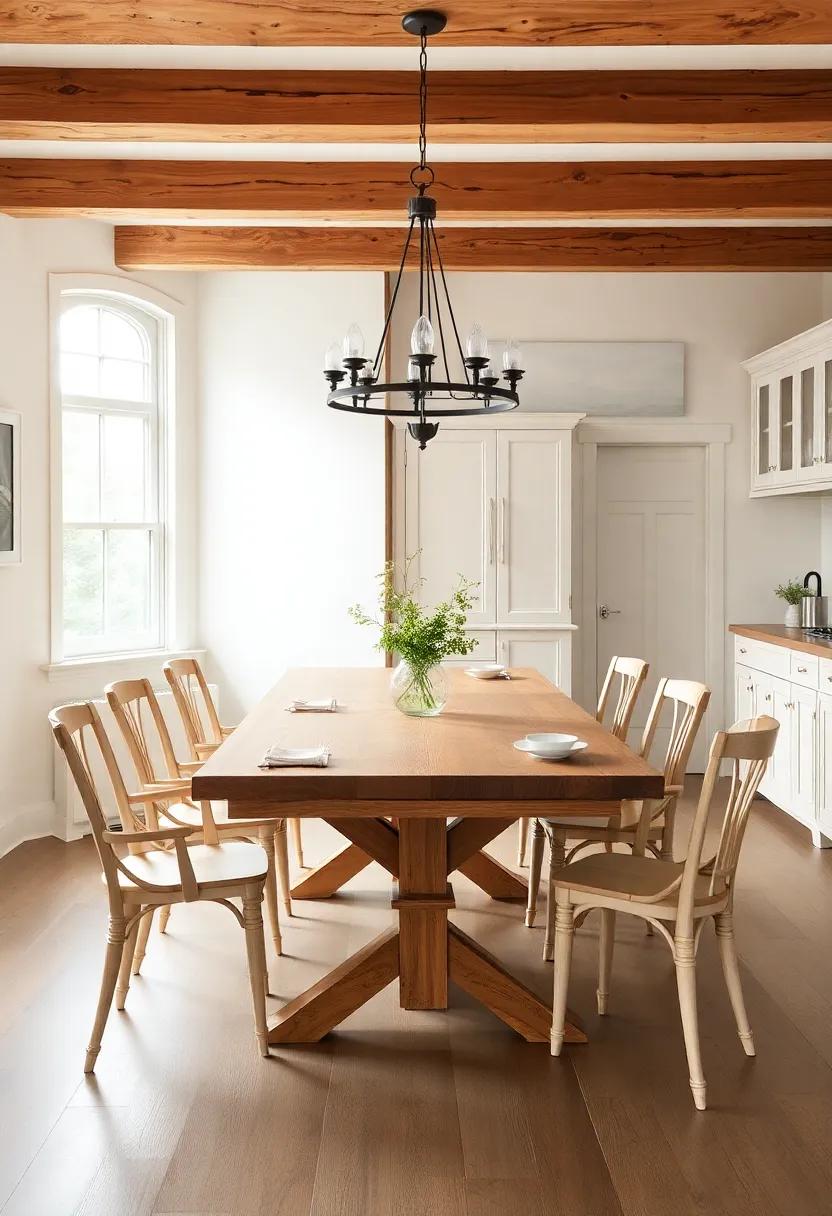
The dining table serves as more than just a piece of furniture; it embodies the spirit of togetherness, where food and conversation mingle to create lasting memories. A well-designed farmhouse table, often crafted from reclaimed wood, evokes a sense of warmth and nostalgia, making it the perfect focal point for family meals. These tables are usually spacious, accommodating everyone from immediate family to visiting friends, transforming every meal into a shared experience. The rustic charm of a farmhouse dining table invites you to linger longer, encouraging the laughter and stories that enrich our lives.
Incorporating elements such as vintage tableware, woven table runners, and fresh floral arrangements can elevate the dining experience even further. Consider these thoughtful decorations to enhance the ambiance:
- Natural Centerpieces: A vase filled with seasonal flowers or fresh herbs adds color and fragrance.
- Layered Textiles: Combine linen napkins, cotton tablecloths, and burlap runners for a cozy aesthetic.
- Unique Tableware: Mix and match plates and cutlery to reflect your personal style and history.
When designing your dining area, remember that the essence of a French farmhouse kitchen is about blending elegance with simplicity.A sturdy yet stylish table can act as a canvas for your creativity, inviting family members to gather around and savor life’s precious moments.
Incorporating Organic Materials for a True French Farmhouse Feel
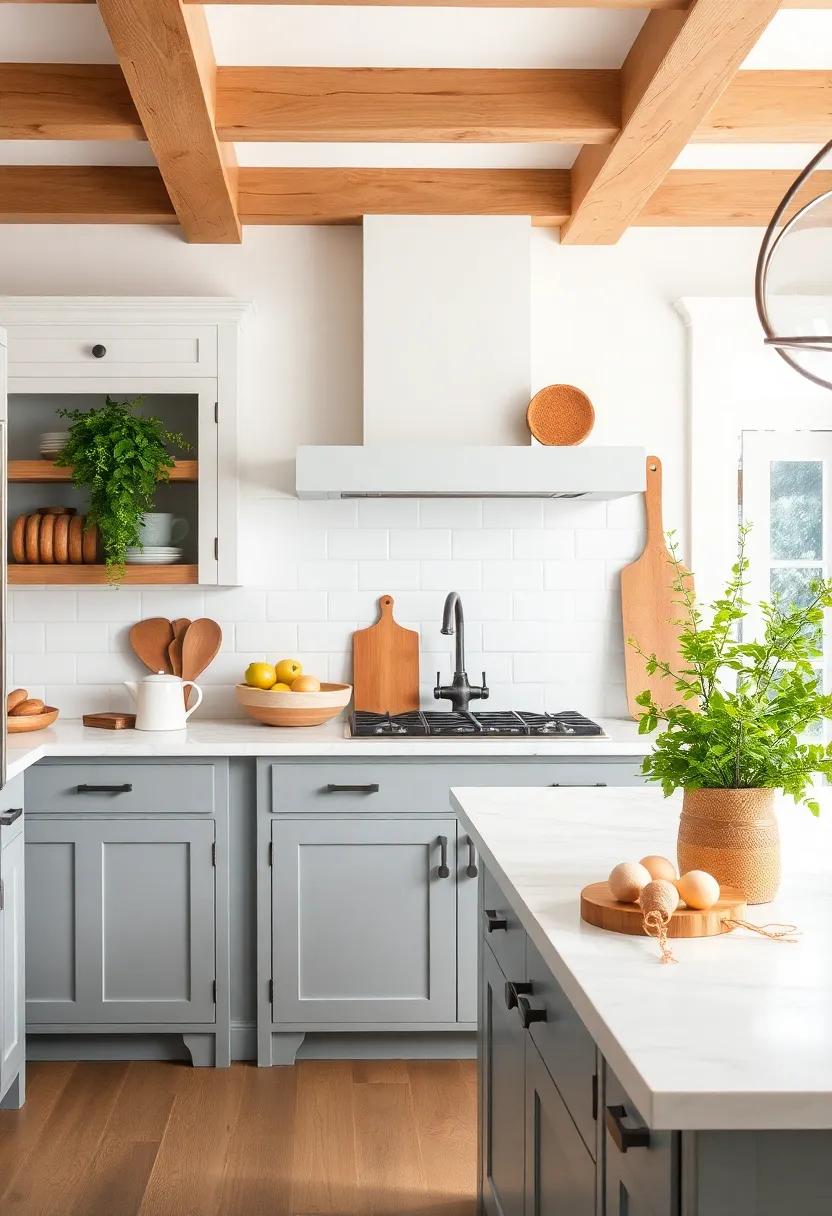
Infusing organic materials into your kitchen design can evoke the rustic charm of a French farmhouse, effortlessly blending elegance with a touch of nature. Think of incorporating elements like weathered wooden beams and stone countertops that bring warmth and earthiness to the space. You can achieve a harmonious look by selecting cabinetry made from reclaimed wood or by using natural finishes that showcase the raw beauty of timber. Consider layering textures through traditional clay tiles or reclaimed bricks for flooring, as they not only provide durability but also a classic aesthetic that pays homage to the French countryside.
To further enhance this organic feel, choose accessories that resonate with the natural world. A few thoughtful choices can include:
- Woven baskets for storage, adding texture and function
- Herb pots in terracotta or ceramic, bringing fresh greenery indoors
- Vintage wooden utensils displayed prominently, showcasing craftsmanship
- Natural fabric linens, like cotton or linen, for a touch of soft elegance
By thoughtfully selecting materials and decor that reflect the beauty of nature, you can create a kitchen that feels both authentic and inviting, celebrating the timeless spirit of French farmhouse design.
Celebrating Handcrafted Details: The Beauty of Artisan Touches in Kitchen Design
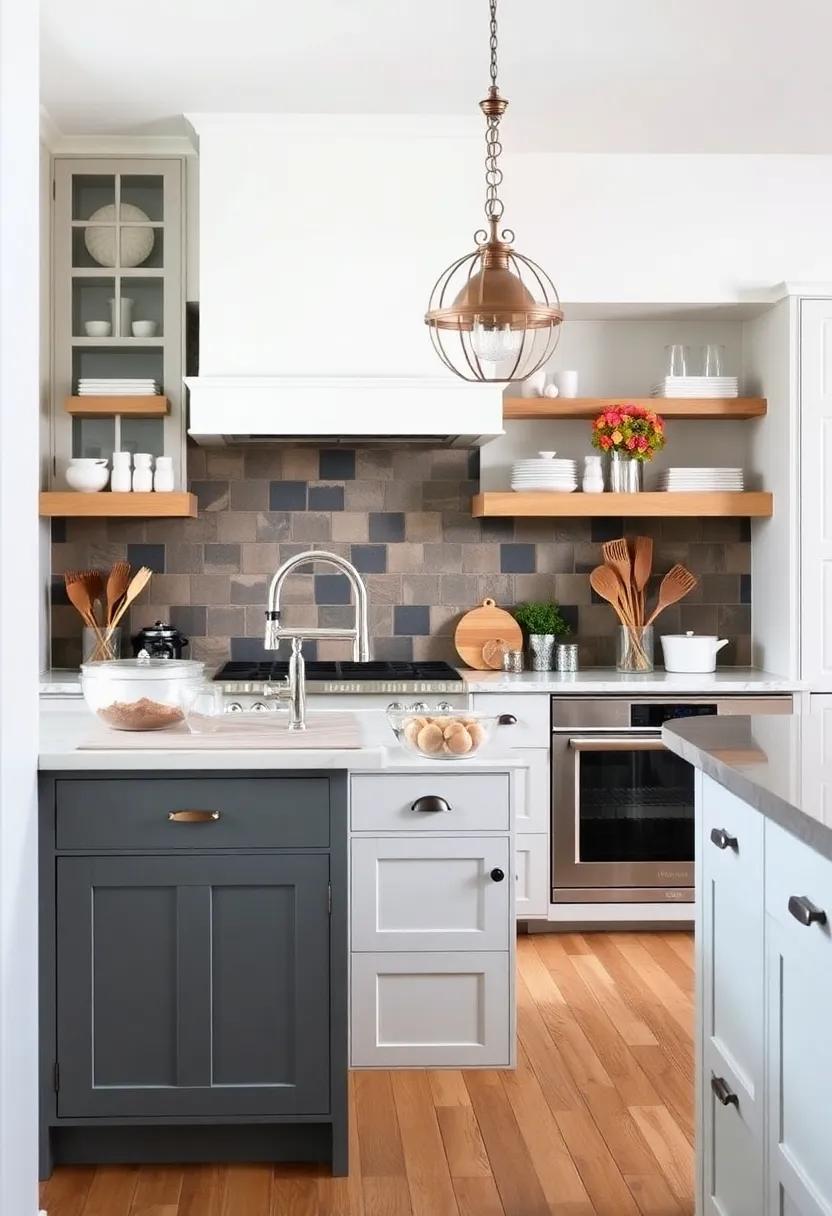
In the realm of kitchen design, the allure of artisanal craftsmanship adds a layer of depth and personality that mass-produced elements simply cannot achieve. Each handcrafted piece tells a story, infusing the space with warmth and individuality. From intricately carved wooden cabinets to hand-forged metal fixtures, these unique details transform a kitchen into a space that feels lived-in and cherished. Embracing the beauty of skilled craftsmanship allows you to create an inviting atmosphere that resonates with the rustic charm emblematic of French farmhouse aesthetics.
Integrating artisanal touches can elevate your kitchen’s overall visual appeal and make for functional enhancements that are just as captivating. consider incorporating elements like:
- Hand-painted tiles: These can serve as stunning backsplashes or accents, adding a splash of color and personality.
- Reclaimed wood: Using salvaged timber for open shelving or beams can provide a distinct weathered look.
- Custom-made islands: A centerpiece crafted by local artisans can serve as both a functional workspace and a conversation starter.
Moreover, the integration of handcrafted hardware—from bespoke knobs to artisan-made lighting fixtures—can tie together the design seamlessly. These elements not only enhance the beauty of your kitchen but also celebrate the skill and dedication of local craftsmen, ensuring that the heart of your home is as unique as you are.
Creating a Functional Layout That Balances Style and Efficiency in Cooking
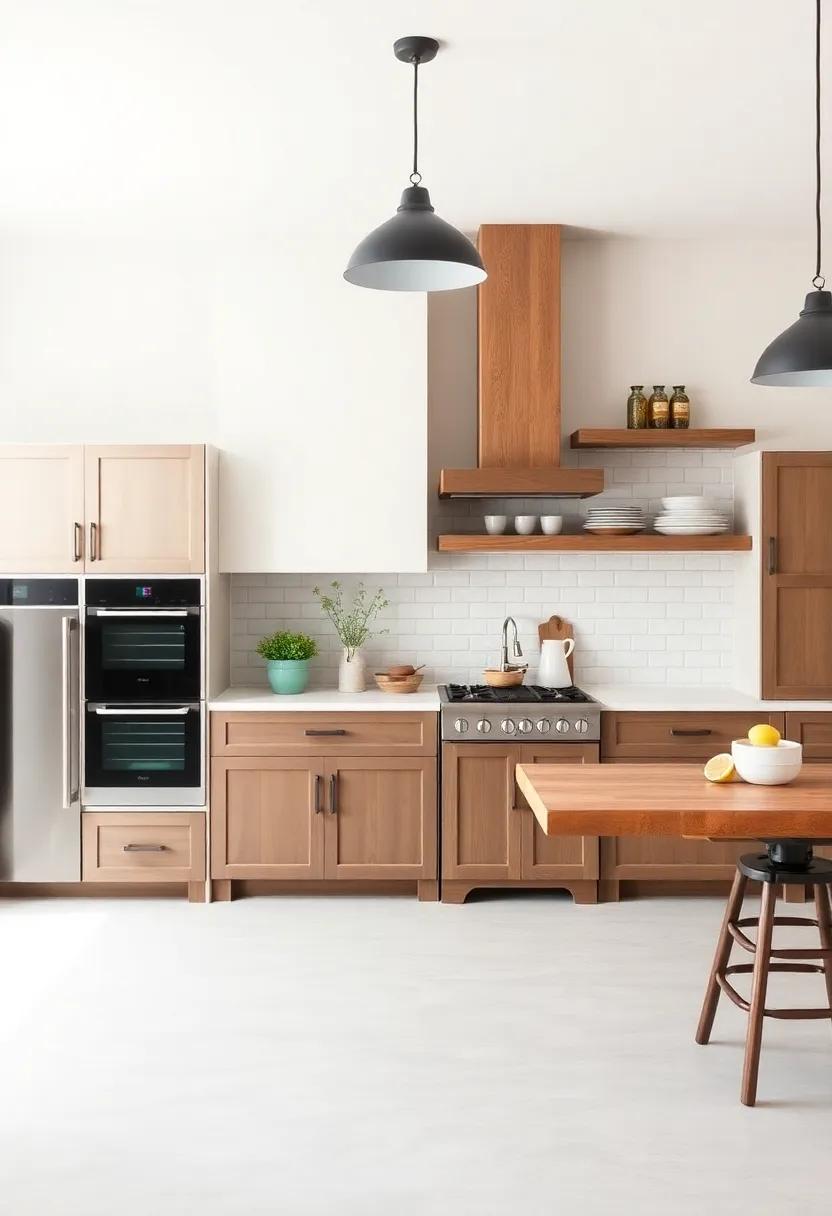
Creating a harmonious and practical kitchen space is the key to elevating your culinary experience. In a French farmhouse kitchen, the layout should not only reflect the rustic charm of the design but also optimize functionality. Consider incorporating open shelving for easy access to dishes and elegant glassware, while large, well-placed countertops provide ample workspace for food prep. An island or breakfast bar can serve as both a central gathering spot and a practical area for meal preparation, ensuring that the kitchen remains the heart of your home.
To strike the perfect balance between style and efficiency, utilize a blend of traditional and modern elements. Choose a color palette that complements natural materials like wood and stone, allowing the space to breathe while maintaining an inviting atmosphere. Maximize storage by integrating cabinetry that stretches to the ceiling, and incorporate thoughtful details such as pull-out organizers and dividers. Below is a helpful summary of essential features to consider in your design:
| Feature | description |
|---|---|
| Open Shelving | Easy access to frequently used items that showcase aesthetic appeal. |
| Large Countertops | Provides ample space for meal preparation, cooking, and entertaining. |
| Kitchen Island | Serves as a multifunctional area for dining and additional workspace. |
| Smart Storage Solutions | Integrates practicality with design through innovative cabinetry. |
Selecting the perfect Lighting Fixtures to Illuminate Your French Kitchen Elegance
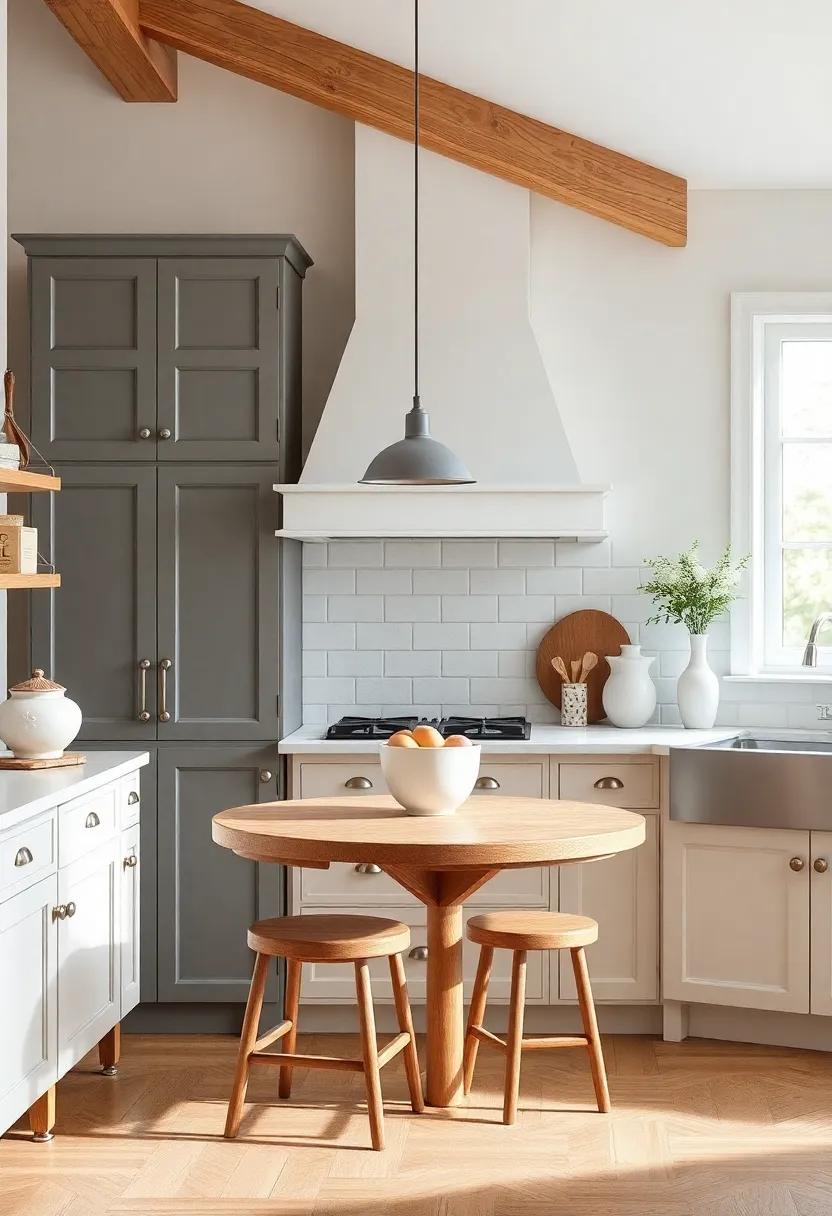
choosing the right lighting fixtures is essential to enhancing the charm of a French kitchen.The warmth and elegance of this design style can be beautifully accentuated by fixtures that reflect an Old World aesthetic. Consider options like chandeliers with intricate wrought iron details that evoke a rustic ambiance or pendant lights featuring glass shades that allow for a soft, inviting glow. Another option is vintage-inspired sconces, which can elegantly frame your kitchen space while providing functional lighting for tasks like chopping vegetables or reading recipes.
When selecting fixtures, keep in mind how they will complement your overall décor. aim for a cohesive look by opting for finishes like antique brass, oil-rubbed bronze, or matte black. To help guide your choices, a simple comparison of styles can be beneficial:
| Style | Characteristics | Best For |
|---|---|---|
| Chandelier | intricate designs, multi-light options | dining areas or focal points |
| Pendant | Variety of shapes, direct overhead light | Kitchen islands or workspaces |
| Sconce | Mounted on walls, ambient lighting | Flanking cabinets or artwork |
Incorporating dimmable features can add flexibility to your lighting design, allowing you to create the right mood for any culinary creation or family gathering. By thoughtfully selecting lighting fixtures that align with your French farmhouse aesthetic, you’ll not only illuminate your kitchen but also enhance its timeless elegance.
Incorporating Herb gardens for Freshness and Flavor in Your culinary Space
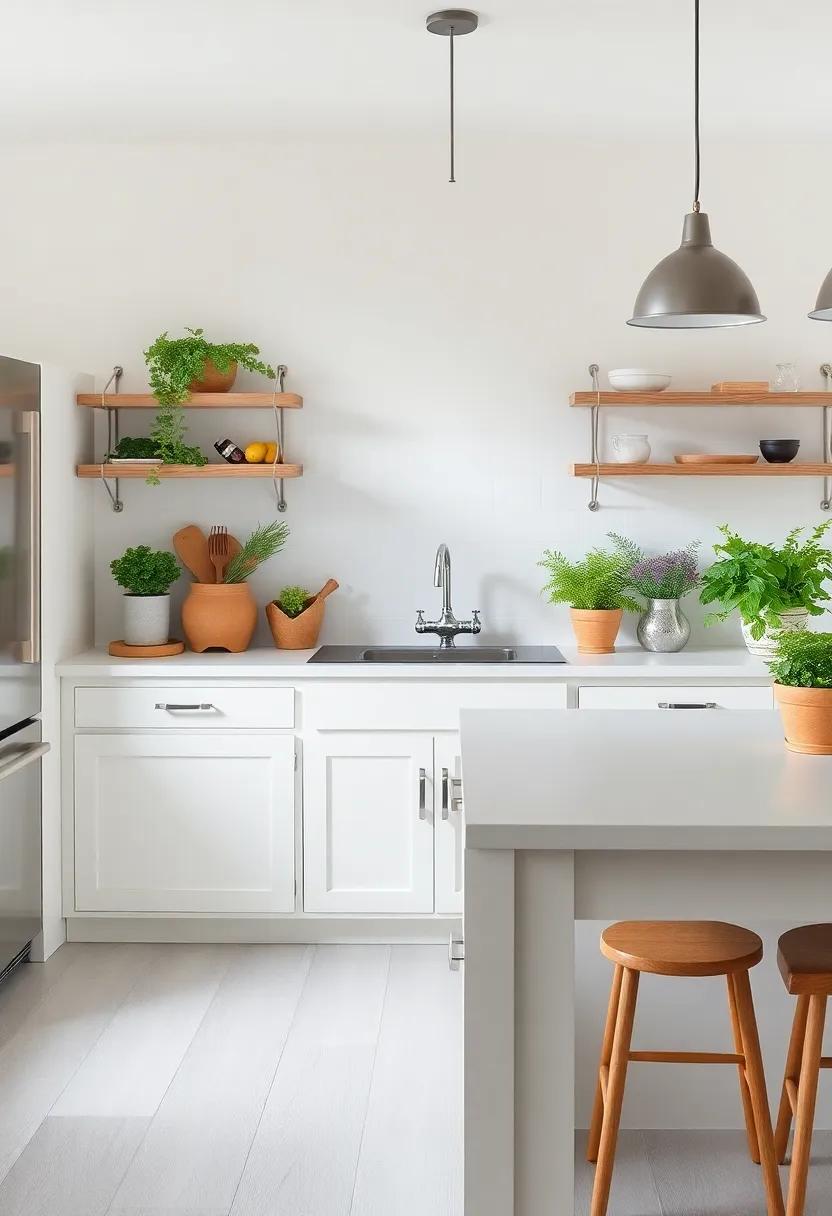
Introducing a vibrant herb garden into your culinary space not only enhances the aesthetic charm of a French farmhouse kitchen but also elevates the flavor profile of your dishes. Imagine a rustic wooden shelf or a quaint window sill adorned with pots of fresh basil, thyme, and parsley, ready to be snipped at a moment’s notice. These aromatic plants not only provide a sensory experience but also add a layer of authenticity to your cooking, connecting you to the tradition of using fresh, locally-sourced ingredients.Consider these options for your herb garden:
- basil – Ideal for adding a fragrant touch to sauces and salads.
- Chives – Perfect for garnishing soups and enhancing vegetable dishes.
- Oregano – A staple in Mediterranean cuisine, great for meats and sauces.
To maximize your culinary experience, integrate an herb garden in ways that harmonize with the rustic elegance of your space. Whether through a tabletop arrangement or wall-mounted pots, the presentation can be as essential as the flavors themselves. By doing so, you encourage spontaneity in cooking, inspiring you to create on a whim.Here’s a simple chart to help you decide where to place your herbs for optimal growth:
| Herb | Best Placement | Growth Needs |
|---|---|---|
| Mint | Cool, partially shaded area | Regular watering |
| Rosemary | Sunny windowsill | Dry soil |
| Cilantro | Shady spot | Well-drained soil |
Creating a Seamless Flow Between Indoor and Outdoor Living Areas
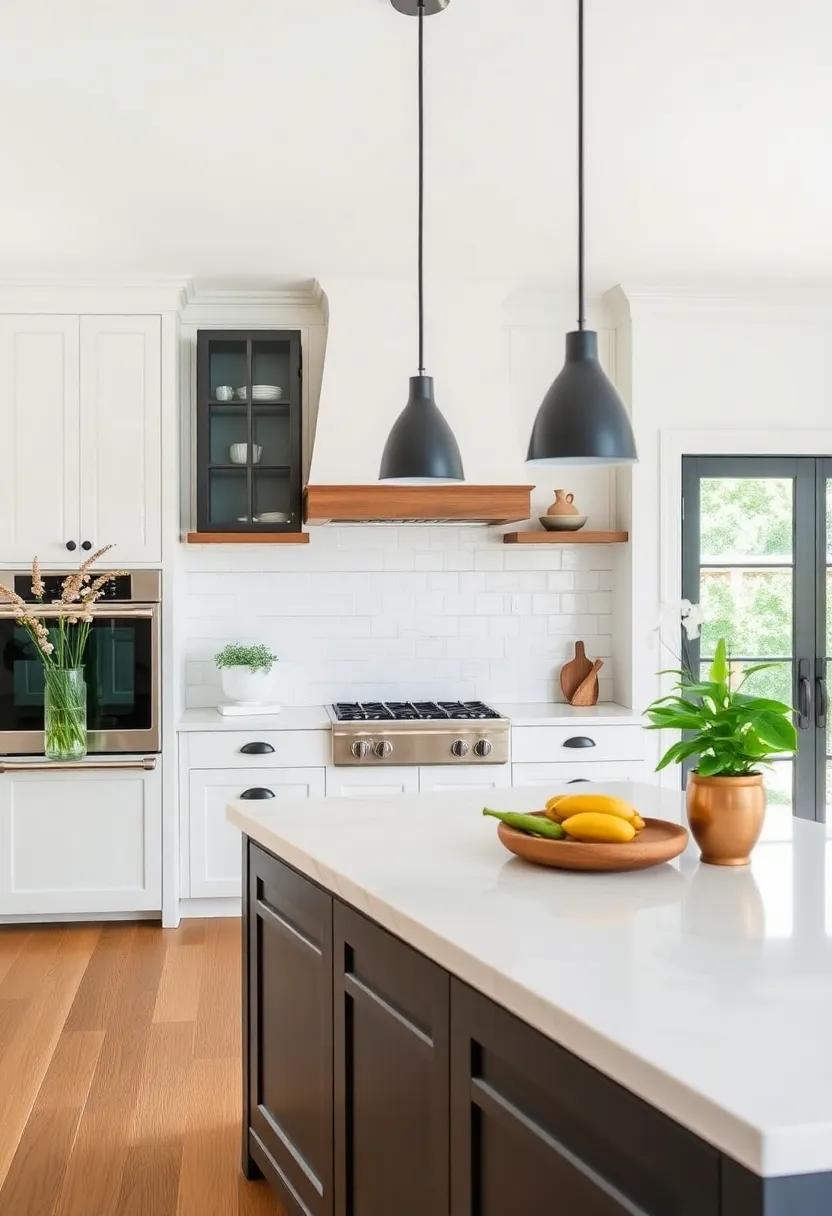
Integrating your indoor kitchen and outdoor living spaces can create an inviting atmosphere that enhances the charm of a French farmhouse design. Consider large folding or sliding glass doors to allow natural light to pour into your home while seamlessly blending your cooking area with a garden or patio. Incorporating natural materials, such as reclaimed wood and stone, can bridge the aesthetic gap, fostering harmony between the interior and exterior. Designing an open-concept layout serves not only functional purposes but accentuates the cozy, relaxed vibe associated with rustic French elements.
To further enhance this connection, select outdoor furnishings that complement your kitchen decor. You might opt for rustic tables and chairs, or an inviting outdoor lounge area where friends and family can gather. Here are some key elements to consider for a cohesive design:
- Consistent Color Palette: Choose earthy tones and muted pastels that reflect natural surroundings.
- Flowing Textures: Use soft fabrics and organic materials that create a tactile connection between spaces.
- Illumination: String lights or lanterns can lead the eye outside while providing ambient lighting for evening gatherings.
the Role of Breathe-Inspiring color Schemes: Blending Soft Neutrals and Earthy Tones
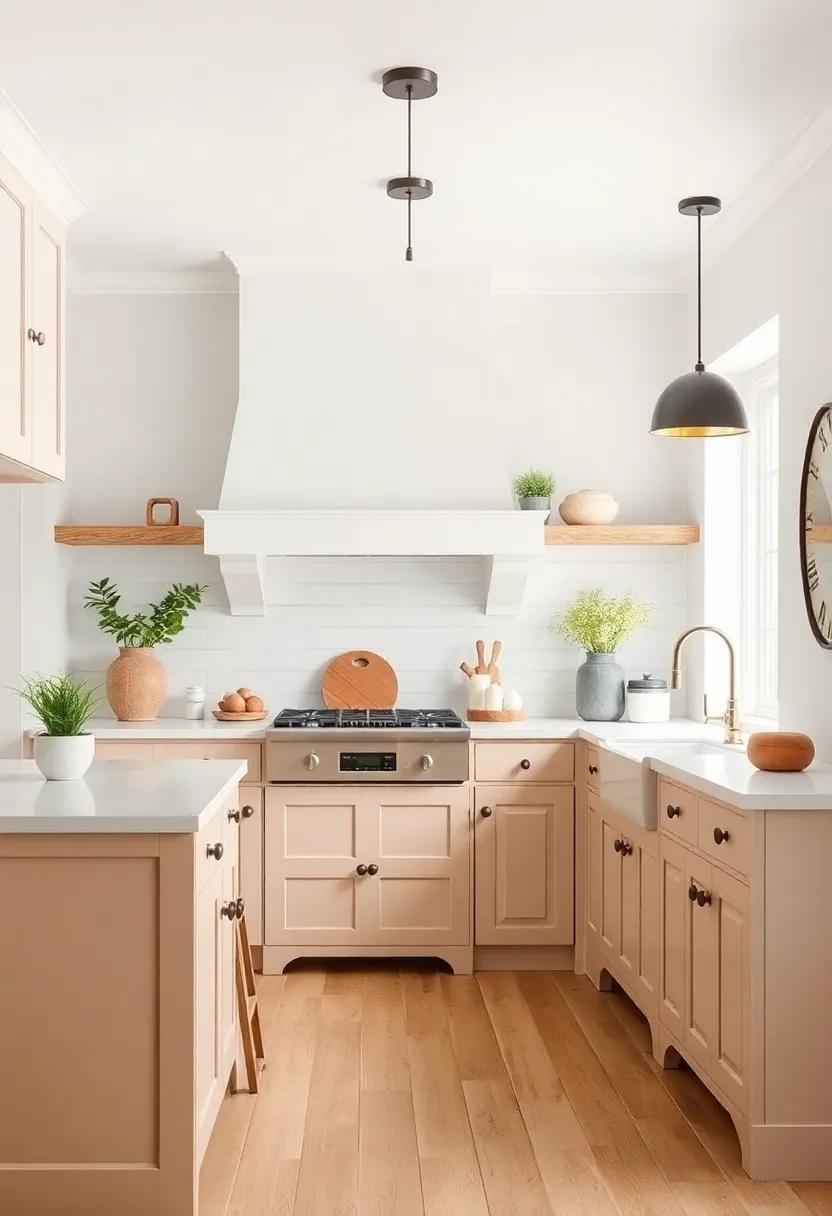
In the enchanting world of French farmhouse kitchens, color schemes play a pivotal role in establishing a warm and inviting atmosphere. The exquisite blend of soft neutrals and earthy tones creates a soothing backdrop that complements the rustic charm inherent in this design style. Shades such as creamy whites,gentle beiges,and muted grays harmonize beautifully with earthy hues like olive greens,terracotta reds,and sandy taupes. Together, these colors evoke a serene ambiance, reminiscent of rolling countryside landscapes, effortlessly bringing a sense of nature indoors.
To successfully implement this color palette, consider incorporating a mix of materials and textures that enhance the overall aesthetic. Natural wood finishes, wrought iron fixtures, and stone accents can amplify the earthy tones while adding layers of depth. Here are a few ways to effectively utilize these colors in your kitchen design:
- Cabinetry: Opt for cabinets in soft, muted hues or distressed finishes that resonate with the farmhouse vibe.
- Backsplashes: Choose tiles that mimic natural stone or have a weathered appearance for added character.
- accessories: Introduce textiles like linen or cotton in neutral shades and throw in occasional earthy tones through pot holders or table linens.
Utilizing Vintage Storage Solutions to Enhance Both Style and organization
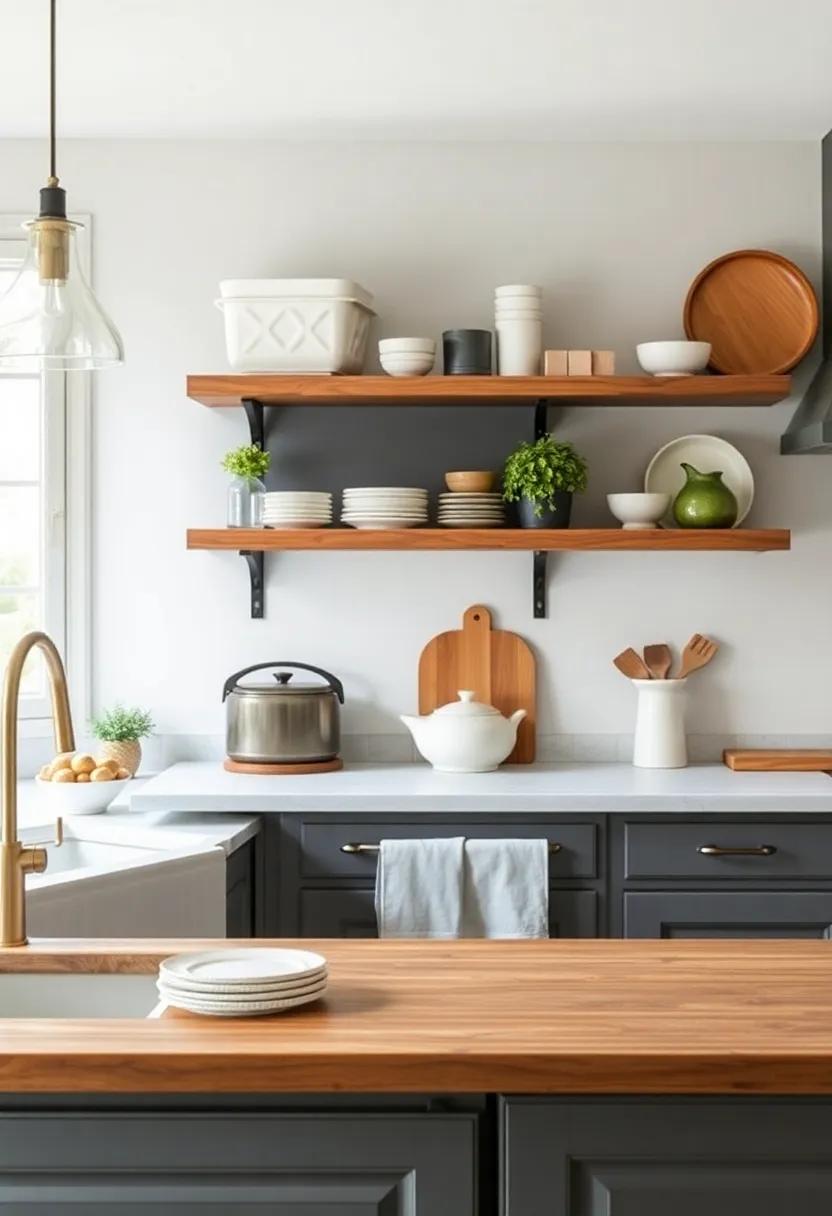
incorporating vintage storage solutions into your French farmhouse kitchen can create a delightful blend of charm and functionality. Think about using distressed wooden crates or wire baskets hung from a rustic rack, which not only add a touch of nostalgia but also keep your produce and essentials organized. Open shelving made from reclaimed barn wood can showcase your collection of antique dishware while simultaneously providing easy access. Here are some vintage storage ideas to consider:
- Apothecary Jars: Perfect for storing dry goods like pasta,spices,and legumes while adding a vintage flair.
- Farmhouse Hutch: A multifunctional piece that can display your china and provide additional storage for kitchen linens.
- Repurposed Furniture: Use old dressers or cabinets for unique storage solutions, ensuring that functionality meets style.
Furthermore,using a combination of open storage and hidden compartments can elevate your space’s organization while maintaining an airy feel. Consider integrating rolling cabinets or carts that can be easily moved, providing both added storage and flexibility for your kitchen layout. Below is a simple comparison of vintage storage styles:
| Storage Style | pros | Cons |
|---|---|---|
| Open Shelving | Accessible, decorative, maximizes space | Dust accumulation, requires organization |
| Vintage Cabinets | Classic look, conceals mess | Can be bulky, may need refinishing |
| Basket Storage | versatile, charming, lightweight | Limited capacity, may require liners |
Bringing Nature Indoors: The Influence of Botanical Elements in Kitchen Design
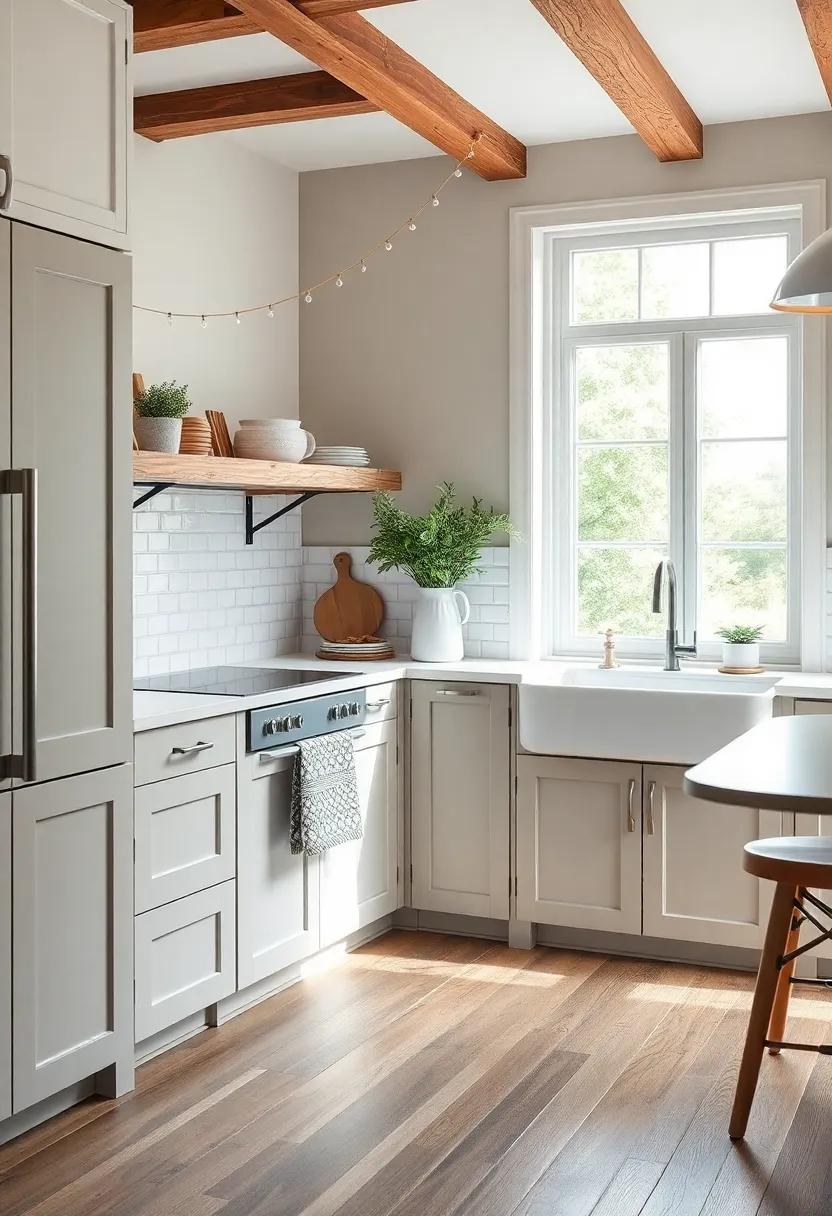
Incorporating botanical elements into kitchen design not only enhances the aesthetic appeal but also infuses a sense of serenity and warmth. From rustic wooden shelves adorned with potted herbs to elegant floral arrangements, these natural additions breathe life into the culinary space. Consider these key features when introducing greenery:
- Herb Gardens: Small pots of basil, thyme, or rosemary on windowsills not only serve as beautiful decor but also provide fresh ingredients for cooking.
- Botanical Prints: Incorporate artwork featuring plants or flowers to create a cohesive theme that celebrates nature.
- Natural Materials: Using wooden or stone elements in countertops and cabinetry reflects the organic beauty of the outdoors.
To create a balanced atmosphere, vary the scale and type of plants used in the kitchen. A stunning centerpiece,such as a large fiddle leaf fig,can command attention,while trailing vines in hanging pots offer a charming touch at eye level. Pair larger elements with subtle details like:
| Element | Effect |
|---|---|
| Succulents | Adds texture and requires low maintenance. |
| Wildflowers | Brings spontaneity and a casual, relaxed feel. |
| Herb Planters | Combines functionality with aesthetics for an inviting workspace. |
Elevating Your Space with Charismatic Flooring options that Reflect French Charm
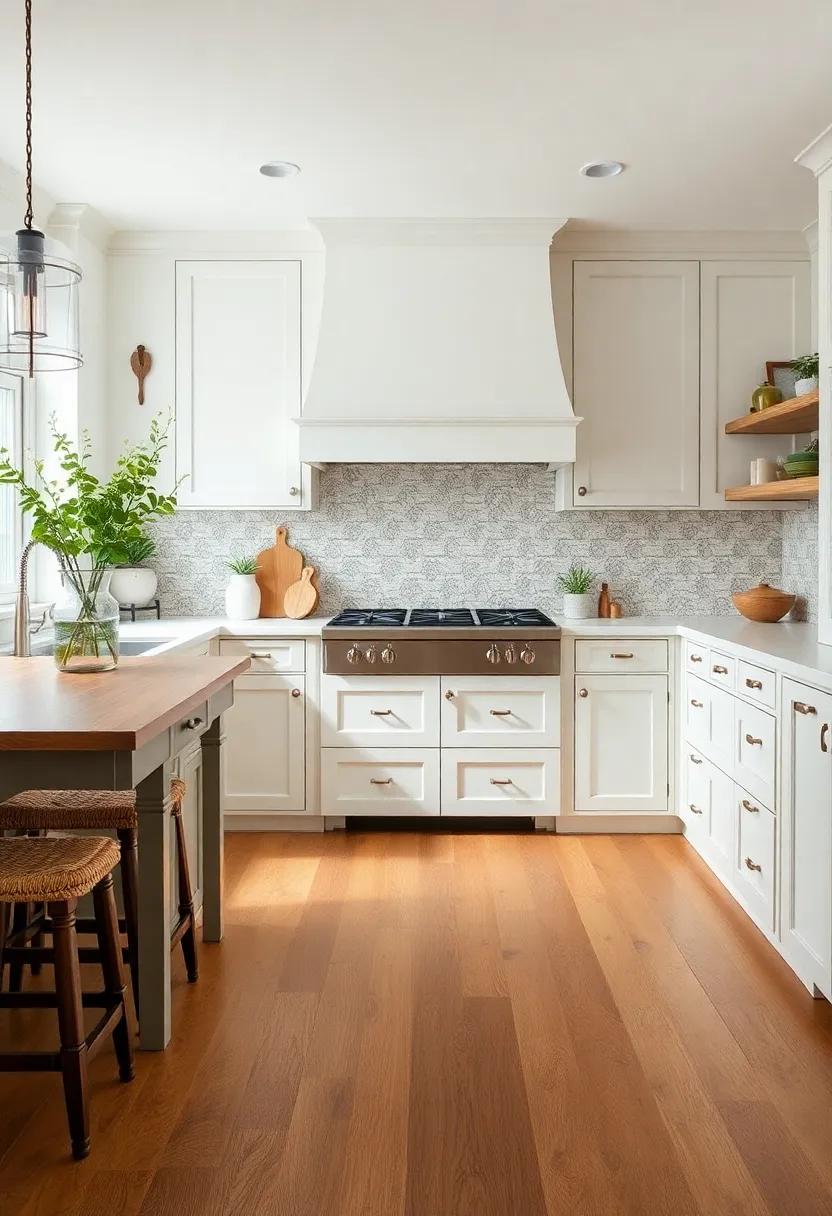
Choosing the right flooring is an essential step in capturing the essence of a French farmhouse aesthetic. The natural beauty of materials such as reclaimed wood and terracotta tiles can instantly elevate your kitchen, creating a warm and inviting atmosphere. Consider these charismatic flooring options to enhance your space:
- Reclaimed Oak Planks: Rich in history, they add character and depth.
- French Terracotta Tiles: Offering earthy tones, these tiles provide a rustic yet elegant finish.
- Wide Plank Pine: Soft and inviting, perfect for a cozy yet chic vibe.
- Chevrons or Herringbone Patterns: A classic choice that brings a sophisticated touch to any area.
Each of these flooring styles not only embodies the charm of French design but also complements the overall aesthetic of your kitchen. Additionally, blending different textures can create a multifaceted look, enhancing the architectural features of your home. For a harmonious ambiance, think about incorporating:
| Floor Type | Key Feature | Ideal Use |
|---|---|---|
| Reclaimed Wood | Unique character | Living areas |
| Terracotta | Natural warmth | Kitchen and dining |
| Engineered Wood | Durability | High-traffic areas |
| Vinyl Plank | Water-resistant | Family-pleasant spaces |
Integrating Antique Finds: How Historical Artifacts Tell Your Culinary Story
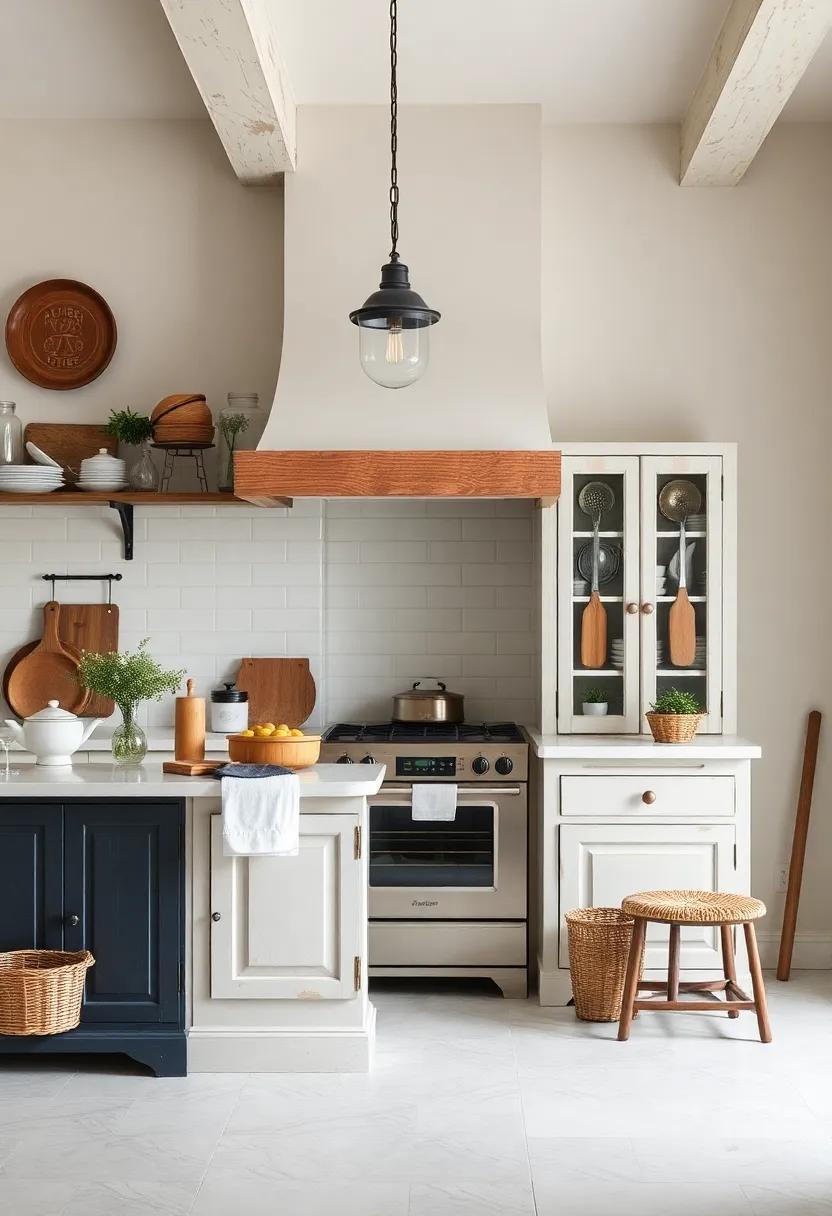
Incorporating historical artifacts into your kitchen decor creates a rich narrative that enhances the overall aesthetic of the French farmhouse style. Antique finds,such as vintage utensils,hand-painted ceramics,and rustic wooden farm tables,can transform a simple cooking space into a vibrant gallery of culinary history. These pieces not only serve as functional tools but also evoke a sense of nostalgia, inviting your guests to engage in the story behind each item. Consider integrating:
- Handcrafted copper pots: A nod to French culinary tradition, these not only look beautiful but are also excellent for cooking.
- vintage aprons: Display them as wall art or use them to add warmth to the space.
- antique spice tins: Perfect for storage while showcasing both class and utility.
moreover, the strategic placement of these artifacts can enhance your kitchen’s charm and functionality. Consider creating a display that highlights your collection, perhaps on open shelving or a repurposed antique cupboard, where every piece can be appreciated. A well-curated mix of heirloom items can set an inviting stage for culinary creativity. Below is a simple table showcasing some ideal antique finds and their potential uses:
| Antique Item | Potential Use |
|---|---|
| French country breadboard | Chopping or serving bread |
| Clay terrines | Baking or serving dishes |
| old-world canisters | Storing dry goods or spices |
Designing an Inviting Breakfast nook for Casual Dining and Morning Gatherings
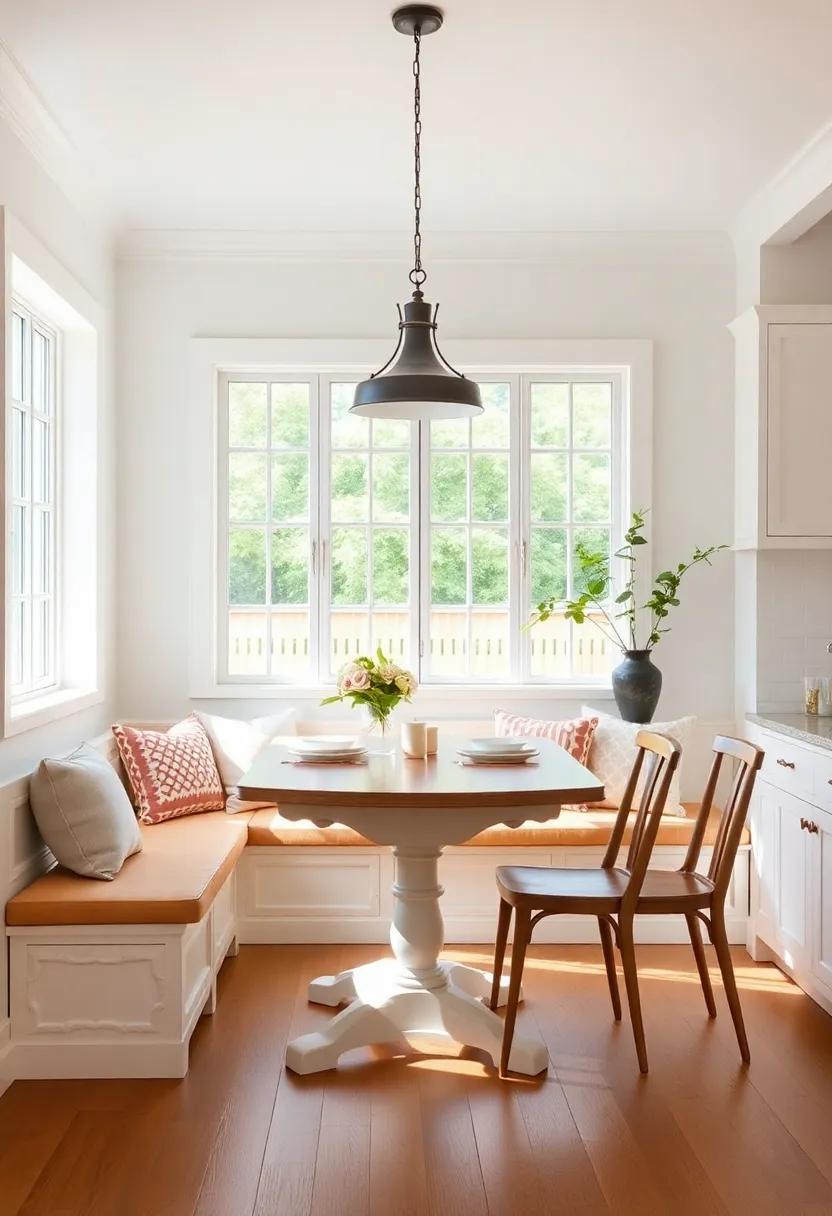
Creating a breakfast nook that invites relaxation and casual conversation begins with the right layout. Choose a cozy, sunlit corner of your kitchen and consider the following elements to enhance the atmosphere:
- farmhouse Table: Opt for a rustic wooden table that exudes warmth and charm.
- Comfortable Seating: Incorporate a mix of cushioned benches and vintage-style chairs to encourage lingering over morning coffee.
- Soft Textiles: Use patterned cushions and a table runner to add texture and color,creating an inviting touch.
The right decor can transform your nook into a charming retreat. Hang soft, sheer curtains to filter natural light and incorporate personal touches such as:
- Seasonal Centerpieces: A vase of fresh flowers or a bowl of seasonal fruits adds life to the table.
- wall Art: Display rustic art pieces or a chalkboard for daily menu inspirations.
- Lighting Fixtures: A pendant light or chandelier can double as a functional source of illumination and a striking visual element.
From Farm to Table: Celebrating the Journey of Ingredients in Kitchen Layout
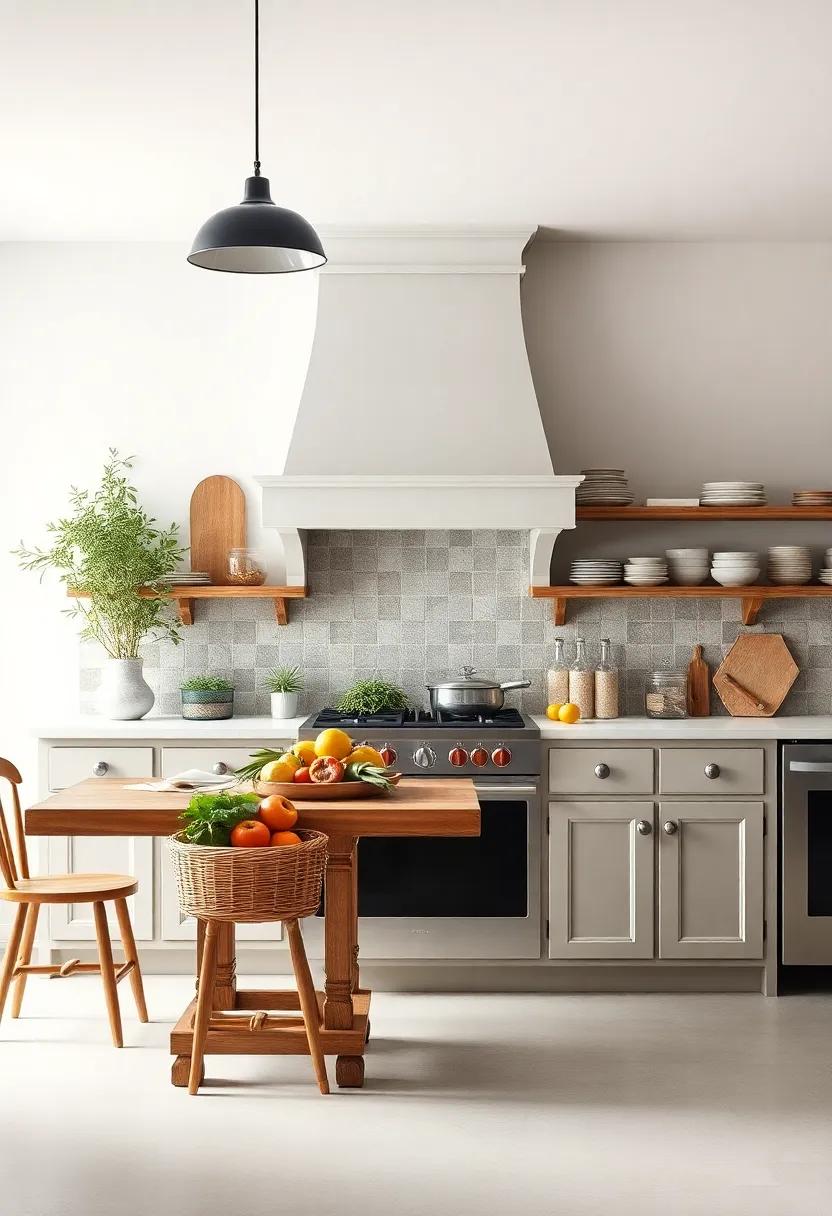
the journey of ingredients from their humble beginnings on the farm to the innovative creations in your kitchen reflects a profound connection to nature and tradition. In a French farmhouse kitchen, this journey is celebrated through thoughtful design that emphasizes natural materials and open spaces. Rustic wooden beams, terracotta tiles, and a warm color palette create an inviting atmosphere that mirrors the charm of rural France. A well-placed pantry stocked with local produce and artisanal goods fosters a sense of community and encourages the use of fresh ingredients in daily meals.
Incorporating features that honor the origins of your ingredients can enhance both the aesthetic and functionality of the kitchen. Consider these elements:
- Open shelving to display handcrafted pottery and fresh herbs.
- A large farmhouse sink that invites you to wash seasonal vegetables directly from the market.
- A central island for preparing dishes while remaining engaged with family and friends.
- Vintage accents such as wrought iron fixtures or a repurposed wooden table to exude history.
Each of these choices celebrates the tactile journey of ingredients, encouraging a heartwarming and communal approach to cooking that reflects the essence of farmhouse living.
A Fusion of French Provincial and Contemporary Styles for Distinctive Kitchen Design
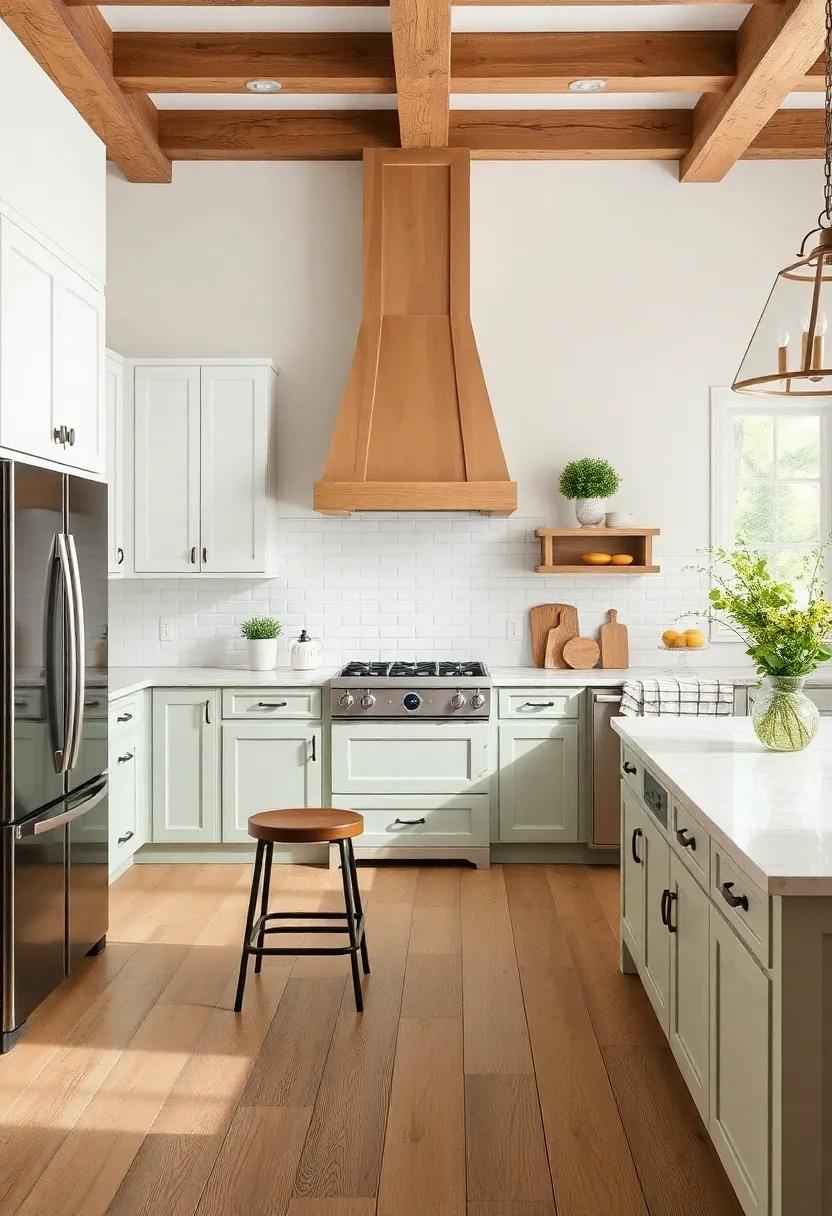
Merging the rustic warmth of French provincial style with sleek, modern lines creates a kitchen that boasts both comfort and sophistication. The inviting ambiance of a French farmhouse, characterized by soft hues, weathered woods, and traditional motifs, harmonizes beautifully with contemporary elements such as open spaces, minimalist fixtures, and streamlined cabinetry. By incorporating natural materials like stone and reclaimed wood alongside polished steel and glass accents, homeowners can highlight a contrast that feels both timeless and fresh.
To achieve this unique aesthetic, consider the following key elements:
- Color Palette: Use muted earth tones with pops of vibrant colors for a balanced look.
- Lighting: embrace vintage-inspired chandeliers paired with modern recessed lighting.
- Furniture: Combine antique farm tables with contemporary seating for a layered effect.
- Cabinetry: Choose modern cabinets with a distressed finish to bridge the styles.
- Accessories: Use ceramic dishware and iron cookware as stylish decor pieces.
In Conclusion
As we draw the curtain on our exploration of French farmhouse kitchen design, it’s clear that this aesthetic transcends mere decoration—it offers a lifestyle steeped in warmth, simplicity, and an enduring sense of elegance.The charm of rustic wood beams, the gentle patina of aged cabinetry, and the inviting aroma of freshly baked bread converge to create a space that feels both timeless and lived-in.
Embracing the principles of this design style invites not just beauty into your home but also fosters a sense of community around the kitchen island, where meals and memories are crafted. As you embark on your own journey toward a French farmhouse kitchen, remember that it’s not merely about the elements you choose; it’s about cherishing the stories they hold and the joys they promise to bring.
In the intricate dance between function and aesthetics, may you find inspiration in the art of imperfection, the allure of handcrafted details, and the soothing palette of nature’s hues. So go forth—let the spirit of la belle vie guide you as you curate your kitchen, making it a sanctuary of elegance and a gathering place for all who enter. The essence of the French farmhouse awaits; all that’s left is to welcome it home.
As an Amazon Associate I earn from qualifying purchases.

